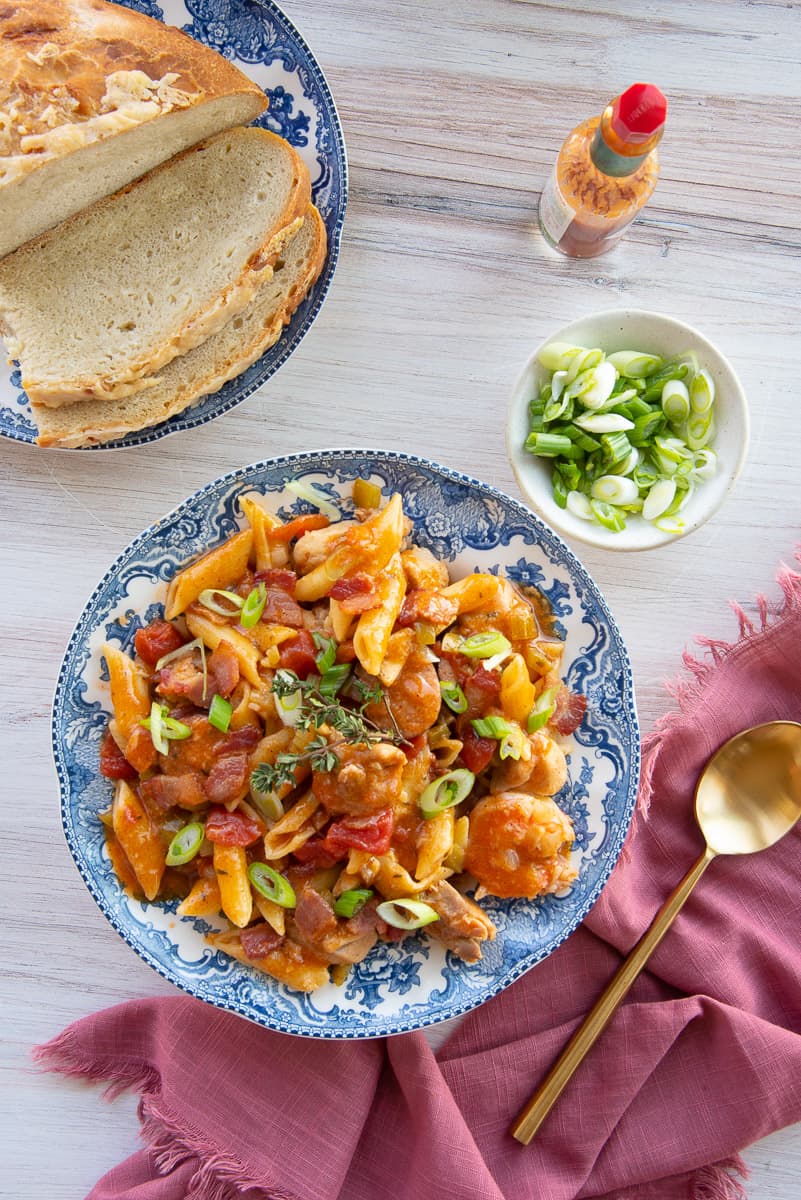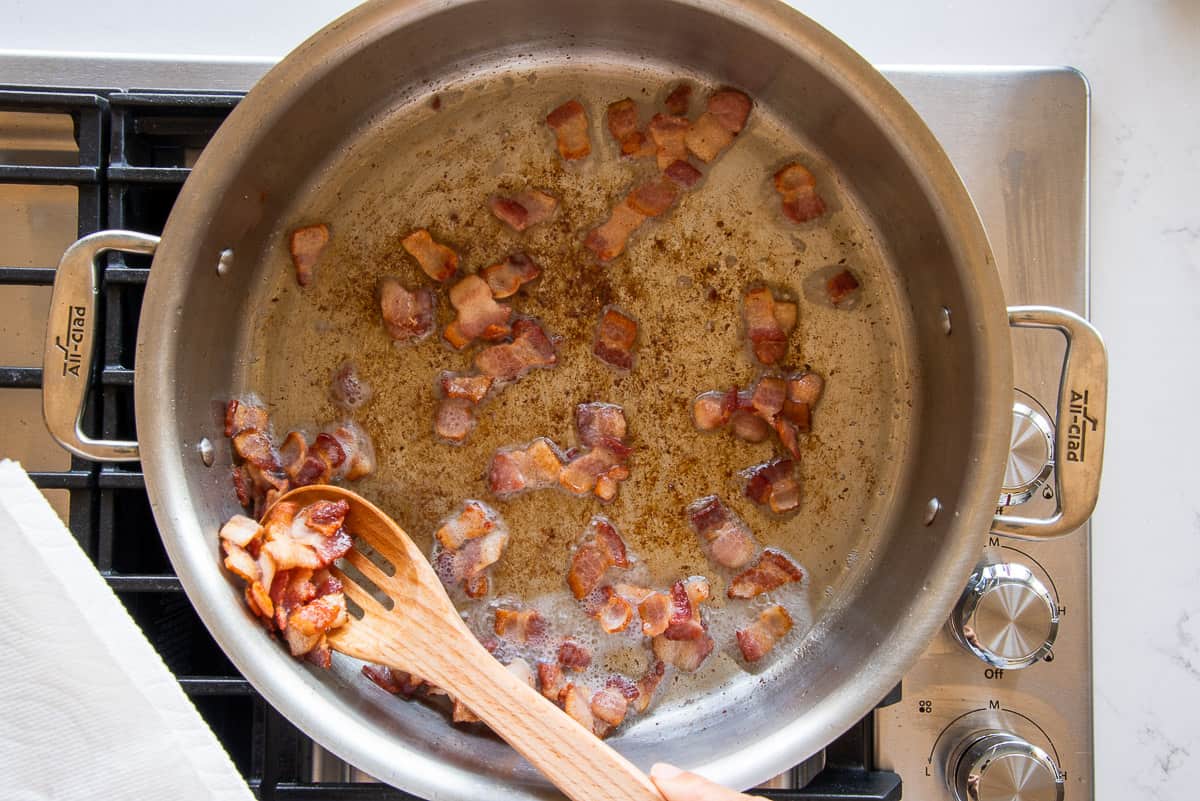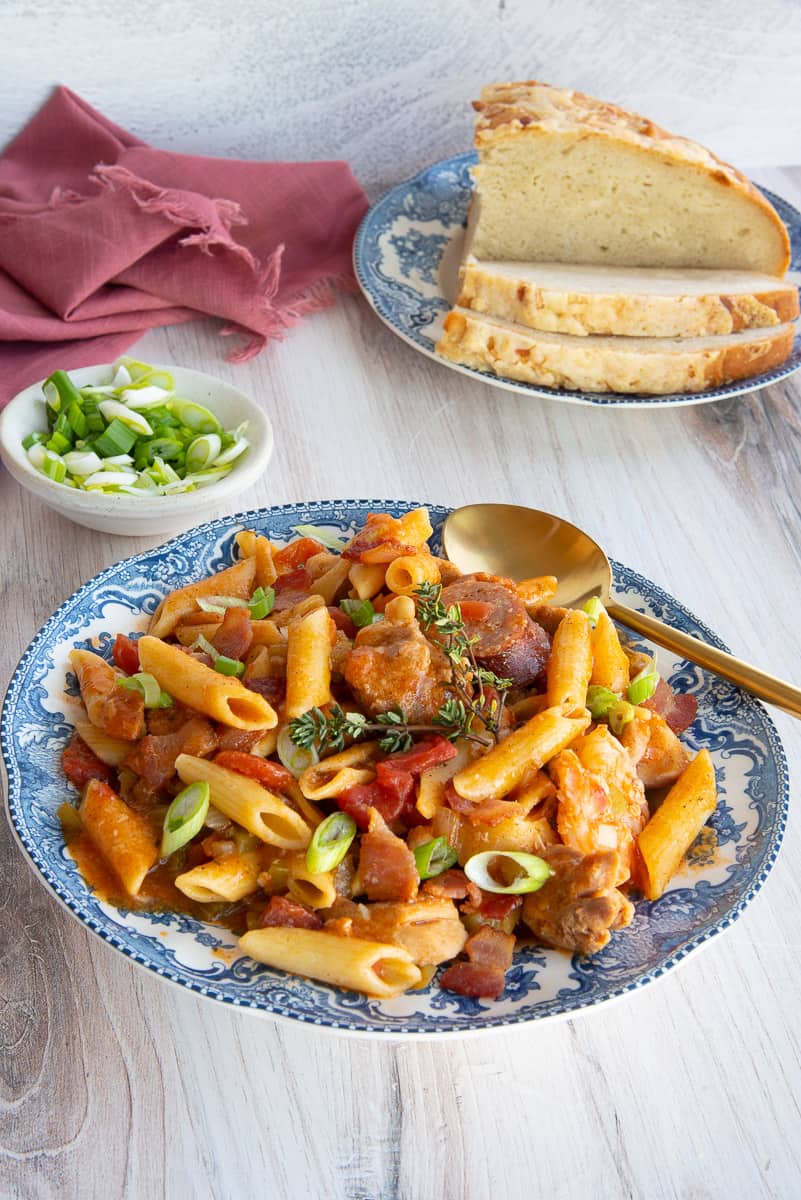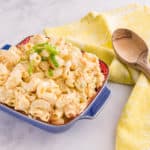Jambalaya Pasta or “Pastalaya” is a delicious recipe with the same great Creole flavors of jambalaya with chicken, sausage, and shrimp, but with pasta, not rice. This hearty one-pot jambalaya pasta is flavorful from the staple of New Orleans cuisine: the holy trinity and a robust tomato-based sauce. It’s a quick weeknight dinner you’re bound to turn to again and again.
This recipe doesn’t contain dairy like the creamy jambalaya pasta, so its flavor is more traditional jambalaya and safe for dairy-free diners.

What is Jambalaya Pasta?
Jambalaya pasta plays on the traditional rice dish Jambalaya from Louisiana. Instead of using rice, as jambalaya does, jambalaya pasta (or pastalaya as it’s commonly called) is made with pasta hearty enough to hold up to the rich sauce, slightly spicy flavors, and proteins contained in the dish.
You’re getting the same classic jambalaya flavors of tomatoes, onion, celery, peppers, and proteins in this dish, with the added comfort of pasta to sop it all up.
Where Does “Pastalaya” Originate?
Jambalaya pasta, or pastalaya, comes from the melting pot of cultures in New Orleans, Louisiana. Some people may not be aware that a large population of Italians settled in New Orleans. I only know because I was obsessed with the mob as a teenager (don’t ask), and Carlos Marcello was a notorious mob boss in the city.
The Italians of New Orleans (and other parts of Louisiana) intermingled their dishes with the French, Cajun, and African populations, and the original jambalaya pasta recipe, AKA pastalaya, was born. This is a Creole jambalaya pasta because it contains tomatoes, whereas Cajun recipes usually forgo them.
Even though jambalaya pasta isn’t a traditional Mardi Gras recipe, it is a great addition to your menu.
What Ingredients Do I Need to Make Jambalaya Pasta?
To make this easy jambalaya pasta, you need to start with the staple of Louisiana cooking, and that is the holy trinity of celery, green bell peppers, and onions; additionally, you need diced bacon, creole seasoning, garlic, diced Roma tomatoes, tomato paste, boneless, skinless chicken thighs, peeled and deveined shrimp, Andouille sausage, bay leaves, and fresh thyme. Choose pasta that holds up to a hearty sauce, like penne, farfalle, or tortiglioni (not to be confused with tortellini). Seafood or chicken broth gives your jambalaya pasta tons of flavor. A combination chicken-seafood broth will add even more flavor, though water is a good substitute.
Save a little prep time with help from the store, and use pre-cut onion, celery, and bell pepper. The same goes for using canned tomatoes, which I’m also doing here. Dried thyme is a great substitute for the fresh herb if you can’t get to the store for it. And, as always, buying your shrimp pre-peeled and deveined is always an option.
Can I Omit the Shrimp or Pork From This Recipe?
Add the shrimp to a small bowl and season it with a fourth of the creole seasoning. Toss the shrimp in the seasoning blend to coat it evenly. Season the diced chicken thighs with another fourth of the creole seasoning in a separate bowl. Allow the chicken and shrimp to marinate while you begin the jambalaya pasta.
If you have a shellfish allergy, you can omit the shrimp in this recipe or replace it with more of the other proteins. You can also replace the bacon and andouille sausage in jambalaya pasta with beef bacon, beef kielbasa sausage, chicken andouille sausage, or a spicy sausage made from another type of meat if you abstain from pork.
How Do I Give My Jambalaya Pasta Flavor?
Bacon gives this pastalaya tons of flavor.
Add the diced bacon to a cold, wide rondeau pot or a large sauté pan without any oil. Set the stove temperature to medium and let the bacon slowly come up to temperature with the pan. This process encourages the bacon to render its fat and leaves you with grease to use when browning the chicken.
After about 10 minutes, the bacon will crisp up. Use a slotted spoon to remove the bacon pieces to a paper-lined plate, leaving the grease behind in the pan. Set the bacon to the side for later.
Can I Replace the Chicken Thighs with Chicken Breasts?
Add the chicken thighs to the pan with the bacon grease. Brown the chicken for 6 minutes over medium high heat. The chicken will be slightly undercooked, which is optimal because it will continue cooking further in the dish. Remove the chicken thighs from the pan using a slotted spoon and set it in the bowl with your sliced sausage.
I prefer chicken thighs in my jambalaya pasta because they don’t dry out as easily as breasts do. You can replace the thighs with boneless skinless chicken breasts if you prefer them, however.
How Long Do I Cook the Creole Sauce?
Add the diced celery, garlic, green peppers, and onion to the grease in the pan. Sauté the aromatics over medium-high heat for 3 to 4 minutes or until they are glossy.
Next, stir in the diced tomatoes, tomato paste, thyme, and the remaining creole seasoning. Cook this mixture until they form a thick sauce in the pan. This cook time is about 10 minutes over medium-high heat.
How Long Do I Have to Cook the Jambalaya Pasta?
Add the seafood stock (or chicken stock), chicken, and sausage to the pot with the rest of the ingredients. Stir in the pasta and bay leaves and allow the liquids in the pan to come up to a gentle boil.
Reduce the heat to medium-low and cover the pan with a lid. Simmer the jambalaya pasta for 15 minutes, stirring once during the cooking period.
Add the shrimp to the pot after 15 minutes of cooking the jambalaya pasta. After stirring in the shrimp, continue cooking the jambalaya pasta for another 5-7 minutes or until the pasta is al dente.
Adding the shrimp at the end of cooking prevents it from becoming too tough. Taste the sauce and add more creole seasoning to suit your preference.
How Do I Serve Jambalaya Pasta?
When the jambalaya pasta is finished, it will look soupy, but as it sits, the pasta will soak up the liquid in the pan. Because of this, you want to remove it from the heat after 20 minutes, or the pasta will become too mushy.
Garnish with sliced green onions and hit it with a little hot sauce before serving. You can serve your jambalaya pasta with a green salad, some Sweet, Buttery Cornbread, or by itself. It truly is a meal all on its own.
What’s the Best Way to Store Leftovers?
Transfer leftover jambalaya pasta to an airtight container and store it in the fridge for up to 3 days. Heat leftover pastalaya in the microwave for 1 to 2 minutes or until it’s warmed through.
Can I Freeze Leftover “Pastalaya?”
To freeze jambalaya pasta, first, allow it to cool, then transfer it to a freezer-safe container. Freeze the pastalaya for up to 2 months.
Thaw jambalaya pasta in the fridge overnight and reheat it in the microwave until warm.
How Can I Make This a Mardi Gras Meal?
A great way to turn this amazing jambalaya pasta into a full-on Mardi Gras meal is to serve this King Cake or these Beignets for dessert afterward!
Let me know what you think of this flavorful Jambalaya Pasta, or Pastalaya, in the comments below. Don’t forget to pin it to your pasta dishes or Mardi Gras boards, and share it with your friends and family, too! It’s one of those one-pot dinners everyone’s bound to love.

Jambalaya Pasta (Pastalaya)
at Sense & EdibilityEquipment
- 6-quart or larger sauté pan or rondeau
Ingredients
- 4 each (1 pound 10 ounces or 725 grams) boneless, skinless chicken thighs cut into 1 1/2" chunks
- 1 pound (475 grams) peeled shrimp deveined and tails removed
- 1 1/2 tablespoons (12 grams) creole seasoning separated
- 6 slices (1/2 pound or 277 grams) thick-cut bacon chopped
- 1 medium yellow onion diced (1 1/2 cups or 200 grams)
- 3 large celery stalks trimmed and diced, 1 1/3 cup or 185 grams)
- 1 medium green bell pepper seeded and diced (1 1/4 cups or 170 grams)
- 5 large cloves garlic minced (about 1/4 cup or 40 grams)
- 1 28-ounce can (794 grams) diced tomatoes or 5 large Roma tomatoes, diced
- 1 tablespoon (15 grams) tomato paste
- 2 sprigs thyme (or 2 teaspoons dried thyme leaves)
- 12 ounce package (397 grams) Andouille sausage sliced 1/2-inch thick
- 6 cups (1 1/2 quarts or 1.5 litres) seafood stock or chicken stock
- 1 pound (454 grams) penne pasta
- 2 large bay leaves
Instructions
Season the Shrimp and Chicken
- Add the shrimp to a small bowl and season it with 1 1/4 teaspoons of the creole seasoning. Toss the shrimp in the seasoning blend to coat it evenly.
- Season the diced chicken thighs with another 1 1/4 teaspoons of the creole seasoning in a separate bowl. Allow the chicken and shrimp to marinate while you begin the jambalaya pasta.
Render the Bacon Grease and Brown the Chicken
- Add the diced bacon to a cold, wide rondeau pot or a large sauté pan without any oil. Set the stove temperature to medium and let the bacon slowly come up to temperature with the pan.
- After about 10 minutes, the bacon will crisp up. Use a slotted spoon to remove the bacon pieces to a paper-lined plate, leaving the grease behind in the pan. Set the bacon to the side for later.
- Add the chicken thighs to the pan with the bacon grease. Brown the chicken for 6 minutes over medium high heat. Remove the chicken thighs from the pan using a slotted spoon and set it in the bowl with your sliced sausage.
Create the Jambalaya Pasta Sauce
- Add the diced celery, garlic, green peppers, and onion to the grease in the pan. Sauté the aromatics over medium-high heat for 3 to 4 minutes or until they are glossy.
- Next, stir in the diced tomatoes, tomato paste, thyme, and the remaining creole seasoning. Cook this mixture until they form a thick sauce in the pan. This cook time is about 10 minutes over medium-high heat.
Cook the Jambalaya Pasta
- Add the seafood stock (or chicken stock), browned chicken, and sausage to the pot with the rest of the ingredients. Stir in the pasta and bay leaves and allow the liquids in the pan to come up to a gentle boil.
- Reduce the heat to medium-low and cover the pan with a lid. Simmer the jambalaya pasta for 15 minutes, stirring once during the cooking period.
Add the Shrimp, then Serve
- Add the shrimp to the pot after 15 minutes of cooking the jambalaya pasta. After stirring in the shrimp, continue cooking the jambalaya pasta for another 5-7 minutes or until the pasta is al dente.
- Taste the sauce and add more creole seasoning to suit your preference. Garnish with sliced green onions and hot sauce, if desired, before serving.
Notes
Swaps and Substitutions:
- If you have a shellfish allergy, you can omit the shrimp in this recipe or replace it with more of the other proteins.
- You can replace the bacon and andouille sausage in jambalaya pasta with beef bacon, beef kielbasa sausage, chicken andouille sausage, or a spicy sausage made from another type of meat.
- You can replace the chicken thighs with boneless skinless chicken breasts.
- A combination chicken-seafood broth will add even more flavor, though water is a good substitute.
- Replace the penne with farfalle, or tortiglioni (not to be confused with tortellini).
Tips and Techniques:
- Save a little prep time with help from the store, and use pre-cut vegetables, canned tomatoes, dried thyme, and peeled and deveined shrimp.
- The chicken will be slightly undercooked, which is optimal because it will continue cooking further in the dish.
- Adding the shrimp at the end of cooking prevents it from becoming too tough.
- When the jambalaya pasta is finished, it will look soupy, but as it sits, the pasta will soak up the liquid in the pan. Because of this, you want to remove it from the heat after 20 minutes, or the pasta will become too mushy.
Storage Instructions:
- Transfer leftover jambalaya pasta to an airtight container and store it in the fridge for up to 3 days.
- Heat leftover pastalaya in the microwave for 1 to 2 minutes or until it's warmed through.
Freezing Instructions:
- Allow the jambalaya pasta to cool completely before transferring it to a freezer-safe container.
- Freeze the pastalaya for up to 2 months.
- Thaw jambalaya pasta in the fridge overnight and reheat it in the microwave until warm.



















Perfect jambalaya flavor! I served with a side salad and everybody cleaned their plates.
It’s so good, right?!